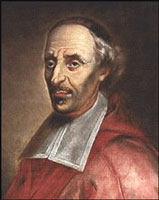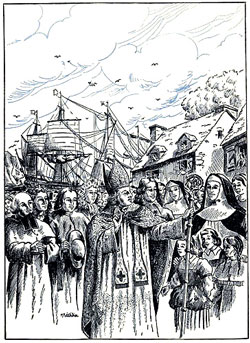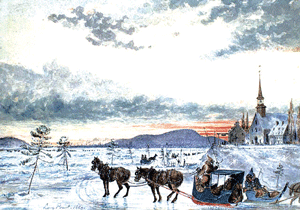 Francois de Montmorency-Laval was born April 30, 1623, at Montigny-sur-Avre in Normandy. From his youth he had the desire to become a priest. In order to prepare himself better, he became a Congregant of the Blessed Virgin on May 1, 1647 and remained one all his life.
Francois de Montmorency-Laval was born April 30, 1623, at Montigny-sur-Avre in Normandy. From his youth he had the desire to become a priest. In order to prepare himself better, he became a Congregant of the Blessed Virgin on May 1, 1647 and remained one all his life.
Dreaming of becoming a missionary, he offered himself, a young priest, to follow Father de Rhodes S.J. to the Far East. This project came to nothing because Providence wanted the King of France Louis XIV, to choose him to be the first bishop in New France. Consecrated December 8, 1658, two centuries before the famous apparitions at Lourdes, he chose to dedicate his cathedral to the Immaculate Conception of the Blessed Virgin Mary, to whom he had a special devotion. The young prelate, only 35 years old, landed in Quebec City June 16, 1659. The French settlers greeted him with great joy.
His first goal is to push vigorously for the organization of the Canadian Church.
To the Jesuit Fathers he confided the apostolate of the Indian Missions. The secular priests were given the job of founding and developing parishes and uninhabited areas for the entire French colony.
 In 1663, he founded the Great Seminary in Quebec to whom he confided the formation of his clergy. Five years later he founded the Minor Seminary. He undertook to make a pastoral visit across his immense diocese. He traveled long distances, on foot, wearing snowshoes in the winter, navigating by canoe when the ice was gone, to visit his large diocese and administer the sacrament of Confirmation. He had the happiness of baptizing the great Indian Chief Garakonthie.
In 1663, he founded the Great Seminary in Quebec to whom he confided the formation of his clergy. Five years later he founded the Minor Seminary. He undertook to make a pastoral visit across his immense diocese. He traveled long distances, on foot, wearing snowshoes in the winter, navigating by canoe when the ice was gone, to visit his large diocese and administer the sacrament of Confirmation. He had the happiness of baptizing the great Indian Chief Garakonthie.
One day, fire broke out in the lower city. Full of confidence, Bishop de Laval descended towards the location of the blaze with the Blessed Sacrament. The flames extinguished themselves before the Blessed Sacrament, and the lower city was saved.
Through the efforts of the devoted prelate the Church was established and grew, but not without great difficulty. In 1665, there were 2,500 inhabitants; they extended to 6,615 in 1673. The parishes increased to a point were there were 25 in 1681. His immense diocese extended from Quebec to Acadia, even to French Louisiana.
 Everywhere he started devotions that continue to this day and that make up our spiritual strength: The Immaculate Conception, Saint Joseph, the Holy Family, the holy Scapular; and Good Saint Anne, whose majestic sanctuary draws millions of pilgrims today. Bishop de Laval said in 1681: "Nothing contributed more to progress in New France than the devotion to good Saint Anne."
Everywhere he started devotions that continue to this day and that make up our spiritual strength: The Immaculate Conception, Saint Joseph, the Holy Family, the holy Scapular; and Good Saint Anne, whose majestic sanctuary draws millions of pilgrims today. Bishop de Laval said in 1681: "Nothing contributed more to progress in New France than the devotion to good Saint Anne."
Upon his arrival in Quebec City, the young bishop became aware of the moral disorder caused by the trade of firewater in the colony. The disaster among the Indians was even worse. Bishop de Laval fought against this disastrous commerce with strength. He confided this cause to the prayers of Sister Catherine of St. Augustine. And he went see the King of France to protest on this subject; but when he returned to the country, he learned with joy that the trade in firewater was ended because of the earthquakes that shook New France and "hearts."
 Without resentment the bishop resisted the encroachment of the civil authorities in the government of the Church, no matter what the insults and denigrations of Mr. de Mésy where. When in 1655 this unfortunate governor became ill, Bishop de Laval assisted at his deathbed.
Without resentment the bishop resisted the encroachment of the civil authorities in the government of the Church, no matter what the insults and denigrations of Mr. de Mésy where. When in 1655 this unfortunate governor became ill, Bishop de Laval assisted at his deathbed.
Concisely, Bishop de Laval did so much for the establishment of the Church in New France, that he merits the title of Founder and Father of the Canadian Church. Pope John Paul II beatified him in 1980.
Blessed Francois de Montmorency-Laval, we pray that you support our Cardinal Marc Ouellet with the power that you have in Heaven to give to our French Canadians the spirit of Faith of our ancestors.
On Sunday, the day that the Lord chose for Himself, all of our ancestors went to the Holy Mass on foot, or in carts pulled by horses.